Intel NUC10i7FNH Frost Canyon Review: Hexa-Core NUC Delivers a Mixed Bag
by Ganesh T S on March 2, 2020 9:00 AM ESTBAPCo SYSmark 2018
The Intel NUC10i7FNH (Frost Canyon) was evaluated using our Fall 2018 test suite for small-form factor PCs. In the first section, we will be looking at SYSmark 2018.
BAPCo's SYSmark 2018 is an application-based benchmark that uses real-world applications to replay usage patterns of business users in the areas of productivity, creativity, and responsiveness. The 'Productivity Scenario' covers office-centric activities including word processing, spreadsheet usage, financial analysis, software development, application installation, file compression, and e-mail management. The 'Creativity Scenario' represents media-centric activities such as digital photo processing, AI and ML for face recognition in photos and videos for the purpose of content creation, etc. The 'Responsiveness Scenario' evaluates the ability of the system to react in a quick manner to user inputs in areas such as application and file launches, web browsing, and multi-tasking.
Scores are meant to be compared against a reference desktop (the SYSmark 2018 calibration system, a Dell Optiplex 5050 tower with a Core i3-7100 and 4GB of DDR4-2133 memory to go with a 128GB M.2 SATA III SSD). The calibration system scores 1000 in each of the scenarios. A score of, say, 2000, would imply that the system under test is twice as fast as the reference system.
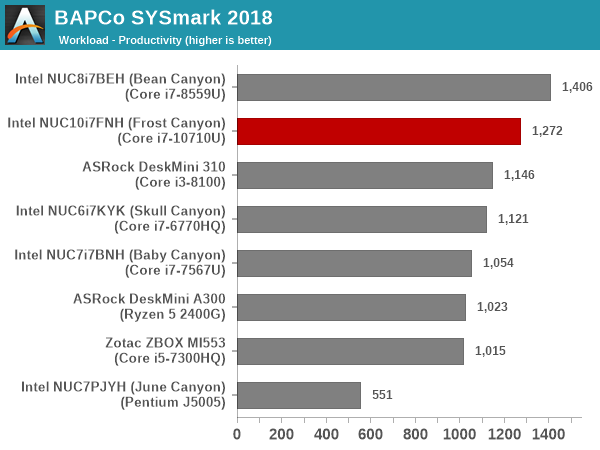
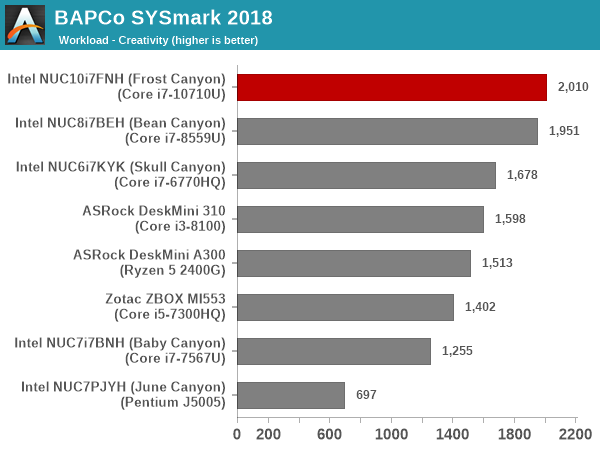
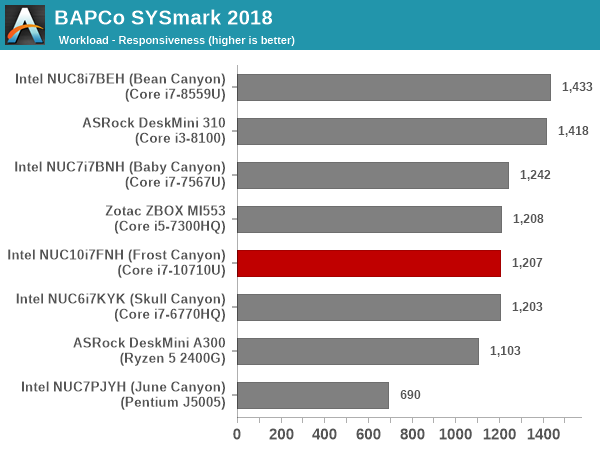
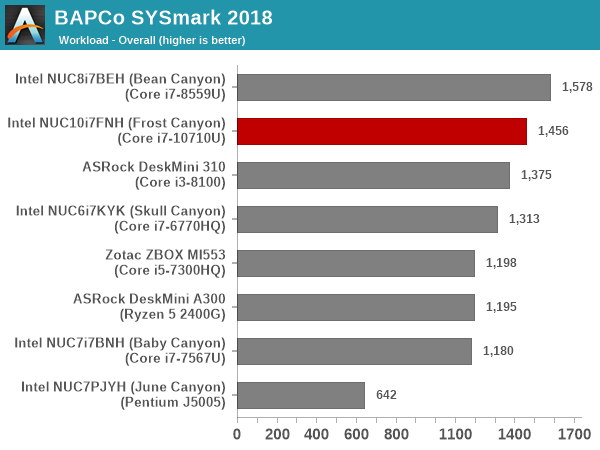
SYSmark 2018 also adds energy measurement to the mix. A high score in the SYSmark benchmarks might be nice to have, but, potential customers also need to determine the balance between power consumption and the efficiency of the system. For example, in the average office scenario, it might not be worth purchasing a noisy and power-hungry PC just because it ends up with a 2000 score in the SYSmark 2014 SE benchmarks. In order to provide a balanced perspective, SYSmark 2018 also allows vendors and decision makers to track the energy consumption during each workload. In the graphs below, we find the total energy consumed by the PC under test for a single iteration of each SYSmark 2018 workload. For reference, the calibration system consumes 5.36 Wh for productivity, 7.71 Wh for creativity, 5.61 Wh for responsiveness, and 18.68 Wh overall.
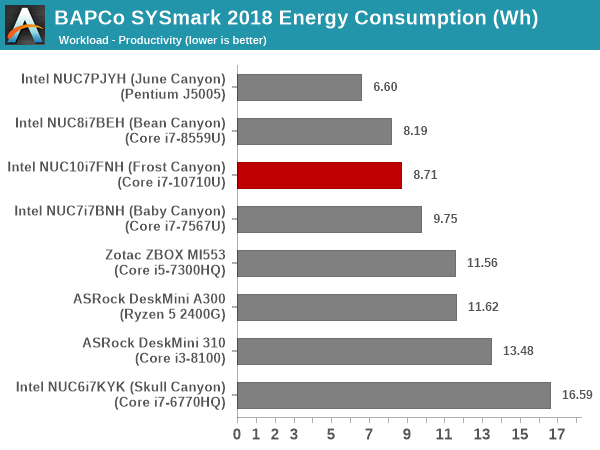
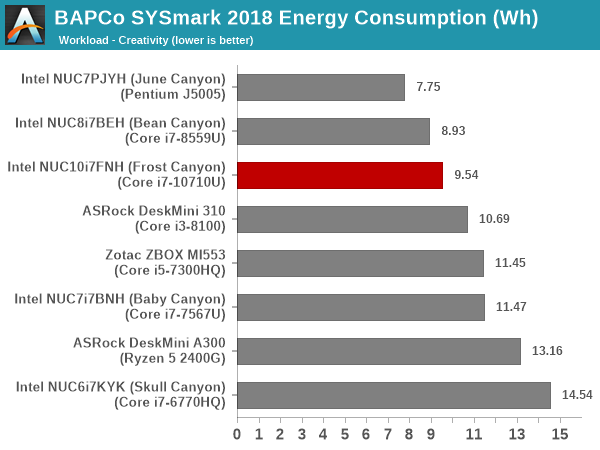
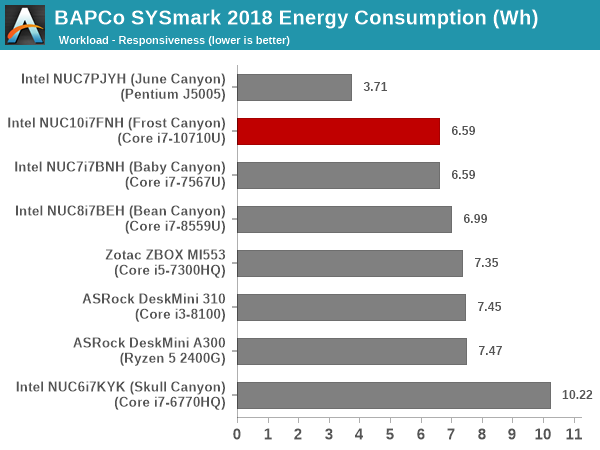
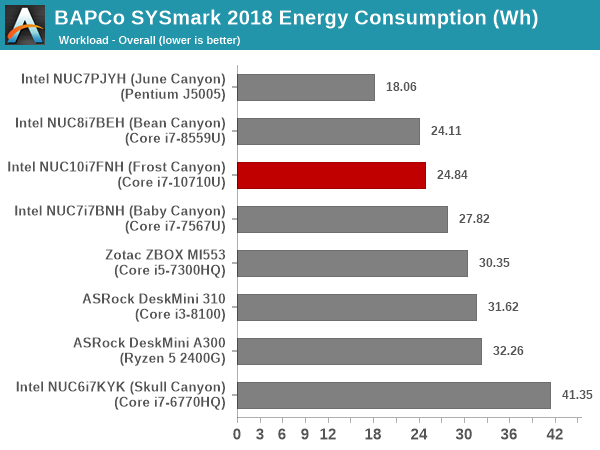
The 'Creativity' workload benefits from the extra cores in Frost Canyon compared to the Core i7-8559U in the Bean Canyon. Our Bean Canyon review configuration is also equipped with a WD Black 3D NVMe SSD (PCIe 3.0 x4) that delivers much better performance compared to the PCIe 3.0 x2 Kingston A1000-class in the Frost Canyon configuration. This results in the responsiveness score for the NUC10i7FNH coming in the middle of the pack compared to the other systems in the sample set. This pulls down the Frost Canyon NUC well below the Bean Canyon NUC in the overall score. The energy consumption is also worse off.










85 Comments
View All Comments
ganeshts - Monday, March 2, 2020 - link
Has been discussed ad-nauseam.If you don't like Bapco's SYSmark, feel free to skip the section.
We believe it presents credible comparison points because it uses *publicly available builds of commercially used software*. The same Adobe applications and MS Office applications are going to be used by consumers whether they have an Intel-based machine or an AMD-based machine.
FWIW, the Frost Canyon numbers in SYSmark actually show that there is no major gains in the benchmark to be had with the addition of the two cores compared to Bean Canyon. Whether people like it or not, most real-world applications fall back on single-threaded performance - Here, Bean Canyon and Frost Canyon are essentially neck-to-neck.
Irata - Tuesday, March 3, 2020 - link
I know this has been discussed a lot, but isn‘t the consensus that it cannot be used as it‘s essentially an Intel sponsored benchmark. I mean nVidia, AMD and Via pulled out for a reason.Also, they have a history of skewing results by stressing certain tasks that feature specific CPU architectures over others going back to the P4 days. Why should this be different now?
James5mith - Monday, March 2, 2020 - link
I have 64GB of RAM in my Bean Canyon NUC running VM's right now. How is this the first one to support it?ganeshts - Monday, March 2, 2020 - link
The keyword is 'officially supported'Max Memory Size is 32GB on this page: https://ark.intel.com/content/www/us/en/ark/produc...
MDD1963 - Monday, March 2, 2020 - link
Pg 1 "... is stil a bit of an unsteady eara" Eara? :)Zok - Tuesday, March 3, 2020 - link
Ugh. Come on! Give me a NUC with 2+ NICs.snowsurferDS - Tuesday, March 3, 2020 - link
The AsRock mini 300 should be tested with a 3400G not a 2400G, at least.dontlistentome - Tuesday, March 3, 2020 - link
Prices keep on going up for no reason (seriously, why should this be so much more epensive than the i7s of a few years ago?).And that power consumption? 64W peak.
next gen the power brick will be bigger than the NUC box.
alpha754293 - Tuesday, March 3, 2020 - link
It's too bad that the thermal management design on these systems are so bad that under heavy CPU and/or CPU+GPU load, it's runs very quickly against the thermal limit, and therefore; has to start throttling itself due to the thermals.If the system had a better thermal management solution and was ACTUALLY able to run at full load for extended period of time, in this form factor, then it would be worth it, else, having a 6-core processor in there is so pointless since you can't even make full use of the previous 4-core CPU in the NUC8.
This is my biggest complaint about my two NUC8s that I have. If it had better thermal management so it wouldn't throttle itself due to thermals, it would present a compelling argument against, for example, the Mac Mini.
ROD.LEE - Tuesday, March 3, 2020 - link
was thinking of upgrading from my NUC8I7BEK, after your review, umm no.